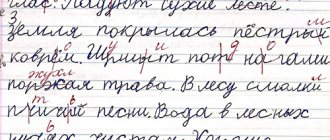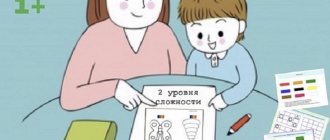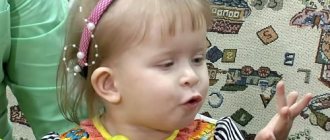Speech therapy presentation for PMPC
Appendix 6.
Speech therapy presentation for primary medical education
Last name, first name of the child
Date of Birth
MARCH 20, 2003
Age
(at the time of examination) 10 years
Class
3A
Brief history of early development
According to my mother, I developed according to age.
Speech environment and social conditions
There are no neuropsychic or speech disorders in parents and immediate relatives.
Articulatory apparatus
fine
Oral speech
General sound of speech
Speech is slurred, rhythm is normal. Uses pauses and stress correctly, speaks in monosyllables, and makes mistakes due to the immaturity of the lexical and grammatical aspects of speech (agrammatism). Intonationally inexpressive (or differentiated). Uses basic types of intonation correctly
speech understanding________________________________________________________________________________
________________________________________________________________________________
Active Dictionary
Limited, characterized by inaccuracy in the use of many words. The most affected is the use of verbs and adjectives, complex prepositional-case constructions; understanding of little-known words (boulevard, herbarium, parcel, etc.), proverbs, sayings, popular expressions. I am not familiar with rarely used vocabulary. Insufficient knowledge about the world around us.
grammatical structure of speech
Agrammatisms are observed during special research: errors in the use of complex prepositions, in the agreement of adjective and noun, verb and noun. There is a misunderstanding and differentiation of constructions with reflexive verbs (the sun illuminates the earth - the earth is illuminated by the sun.
Incorrect use of prepositional case constructions (The leaves on the trees have turned yellow.) Agrammatisms in the formation of adjectives from nouns (blueberry juice).
Incorrect use of animal names and names of baby animals.
General poverty and lack of differentiation of the grammatical means of the language.
Primitiveness of syntactic constructions.
syllabic structure of speech
Makes isolated mistakes when reproducing little-known four-syllable words with consonant clusters (mainly assimilations, simplifications of consonant clusters, omission of syllables).
Sound pronunciation
Monomorphic disorder of sound pronunciation:
Phonemic perception: /sound analysis and synthesis/
There are difficulties in differentiating hard and soft, voiced and voiceless sounds.
Connected speech
Stuttering________________________________________________________________________________________________________________________________________________________
Features of written speech
Dysorphography. Manifestations: a large number of spelling errors, inability to apply spelling rules according to the school curriculum for the corresponding period of study.
Dysgraphia.
Conclusion:
For recommendations based on pedagogical observations and problems in the educational process, I request the consultation of a neuropsychiatrist
Date of examination: 02/08/13. Signature of the specialist_________________
Appendix 7.
Anamnesis*
(provided at PMPC if there is no medical card from the clinic)
1. Heredity is not psychopathologically burdened / burdened
________________________________________________________________________________
________________________________________________________________________________
2. A child from_____pregnancy that proceeded normally /with complications/ _____________
________________________________________________________________________________
________________________________________________________________________________
3. Childbirth (term / premature) ________________________________________________
Without complications/with complications/________________________________________________
________________________________________________________________________________
4. Apgar score________, _weight__________, height _______________
5. Vaccinations _____________________________________________________________________
6. Diagnosis upon discharge from the maternity hospital________________________________________________
7. Early psychomotor development:
8. Diseases under one year of age_________________________________________________________________
9. After a year__________________________________________________________________________
_______________________________________________________________________________
10. Childhood infections ____________________________________________________________
11. Operations (presence of anesthesia)______________________________________________________________
12. TBI__________________________________________________________________________ 13. Registered as “D”/not registered__________________________________________________________
14. Neurological status______________________________________________________________
15. Mental status____________________________________________________________
______________________________________________________________________________
*to be completed by the educational institution medical worker
Speech Therapy Presentation
FOR PMPK.
- Speech environment and social conditions:
• There are no neuropsychic, chronic somatic diseases, or speech disorders in parents and close relatives (denied).
- Speech defects in loved ones.
- 2- tongue.
- Hereditary diseases:
- The level of parents is low.
- The upbringing process is under control or not, they are interested in the problems of their child, parents have little communication with the teacher (speech therapist), and do not pay enough attention.
- Not enough attention is paid to appearance.
- Insufficiently developed general social and everyday skills (not
neatly dressed, casually dressed, “dirty”).
- Parents are not interested in the life of the class.
2. State of manual motor skills (range of movements, pace, ability to switch, presence of left-handedness):
- Fine motor skills of the hands are poorly developed.
- There are no impairments of manual motor skills.
- Prefers to work with his left hand (or sometimes works with his left hand)
- The leading ones are the right hand, the right leg, the right eye.
- Head performs tests correctly; with isolated errors, slowly.
- The optical-kinesthetic organization of movements is formed; not sufficiently formed: performs movements with errors, slowly.
- When performing exercises on the dynamic organization of movements, inaccuracies are also observed (synchronous movements of the fingers of the right and left hands).
3. Gross motor skills:
- Impaired switchability of movements (not timely, delayed).
- Associated movements appear.
- Impaired coordination - movements are not performed simultaneously, inaccurately.
- There is a general inhibition of movements.
- Characteristic motor restlessness.
- Slow in movements.
- General coordination is impaired. Clumsy.
4. Articulatory apparatus:
• Anatomical structure of the organs of the articulatory apparatus without
anomalies.
- Facial structure
not violated (violated)
- Facial muscle tone
intact or impaired (hypertonicity, hypotension, dystonia)
- Mobility of facial muscles
not broken, broken
(chin tremor, hypomimia, hyperkinesis).
- Lip structure
normal or abnormal (massive lips, presence of a cleft, presence of postoperative scars)
- Lip tone
not impaired or impaired (hypertonicity, hypotension, dystonia)
- Lip mobility
not broken or broken –
(sedentary, excessively mobile)
- Structure of teeth
normal ; violations - large, small, rare, frequent, crooked, outside the jaw arch, with large gaps, absence of incisors (lower, upper); presence of extra teeth, dentition disorder.
- Hypoglossal ligament
shortened
- Bite
correct ; violated - anterior open, lateral open, prognathia, progenia.
- Structure of the hard palate
not violated
- Structure of the soft palate
and mobility is not impaired
- Language structure
not broken .
Abnormalities are noted - thick, small, massive, wide, narrow, forked, shortened frenulum.
- Muscle tone of the tongue
fine; impaired – spasticity, hypotension, dystonia.
Tongue mobility
not broken; disorders - hyperkinesis, tremor, deviation (deviation) of the tongue (to the right, to the left); the tongue is not removed from the oral cavity, the range of articulatory movements is limited; decreased amplitude of articulatory movements, inactive, has difficulty maintaining a posture, has difficulty switching the position of the tongue, movements of the tip of the tongue are impaired. Salivation.
• Speech motor skills
sufficiently developed; within normal limits; not enough. Performs basic articulatory movements with lips and tongue. Movements are slow. Cannot maintain the position of the organs of articulation for a long time. The coordination of movements of the tongue and lips is impaired. The differentiated movements of the tip of the tongue are slightly impaired. The range of movements of the tongue is full; incomplete. The tone is normal; sluggish. The duration of the movements and the tempo of the movements are normal. No substitutions of movements or synkenesis are observed. Synkenesis and movement replacements are noted.
5. Oral speech.
General sound of speech:
- Unintelligible (clear, blurry, difficult to understand for others).
- The rhythm is normal. Excessively stretched.
- Speech rate is slow (fast).
- Expressive.
- Not rushed (excessively fast).
- Little talkative.
- Uses pauses and stress correctly.
- He speaks in monosyllables.
- Makes mistakes due to unformed lexical and grammatical aspects of speech (agrammatism).
- Intonationally inexpressive (or differentiated). Uses basic types of intonation correctly.
- Speech intelligibility is not impaired.
- Speech intelligibility is slightly reduced.
- There is arrhythmia, a slowdown in rhythm at the end of a phrase or text.
- Uses word stress correctly.
- There is no logical stress.
- Uses pauses in speech too often.
- The voice is quiet, strong, sonorous, hoarse, trembling, nasalized.
(Voice (normal volume / loud / quiet / fading / dull / ringing / monotonous, weakly modulated / modulated.)
• Breathing type
diaphragmatic, speech breathing is smooth; not smooth enough, speech exhalation is long; not long (4-5 words).
6. Speech understanding:
- Difficult, instructions require repeated explanation.
- He understands the speech of others in accordance with his level of intelligence.
- The state of biological hearing according to the medical record is normal.
- The state of speech perception is normal. Correctly performs actions according to verbal instructions.
7. Lexicon:
- Passive and active vocabulary is characterized by poverty and inaccuracy in the use of many words.
- The use of verbs and adjectives suffers most; generalizing nouns, understanding little-known words (apiary, beehive, waterfall, shoulder straps, hammock, trunk, fountain, boulevard, herbarium, parcel, etc.)
- Limited, poor. Sufficient. Relatively developed.
- Insufficient knowledge about the world around us.
- Familiar with rarely used vocabulary.
- The relations of antonymy and synonymy are unformed.
- Low level of practical generalizations.
- Difficulties in understanding and using vocabulary.
8. Grammatical structure of speech:
a) No violations. No agrammatisms were found in spontaneous speech.
b) Agrammatisms are observed during special research: errors in the use of complex prepositions, in the agreement of adjective and noun, verb and noun.
c) Agrammatisms when forming adjectives from nouns, when forming new words by analogy.
d) Gross violations.
- In speech he uses mainly simple common sentences. In rare cases, complex sentences are noted.
- Makes sentences based on supporting words.
- Complex sentences based on pictures (uses conjunctions - a, but, and).
- Complex sentences are noted only in isolated cases (because; despite; although; when; which; therefore).
- Errors in the use of prepositional-case prepositions, complex prepositions, case endings of plural nouns;
- There are agrammatisms in normal speech; incorrect agreement adj. with noun (The girl has a red dress)
- Incorrect use of prepositional case constructions (The leaves on the trees have turned yellow.)
- There is a misunderstanding and differentiation of constructions with reflexive verbs (the sun illuminates the earth - the sun illuminates the earth)
- Agrammatisms in the formation of adjectives from nouns (blueberry juice).
- Incorrect use of animal names, names of baby animals
- Corresponds to the developmental characteristics of his mental development; children of primary school age.
- Understands and uses prepositions.
- Uses prefixes to form nouns. and ch.
- General poverty and lack of differentiation of the grammatical means of the language.
- primitiveness of syntactic structures.
Types of violations:
- changing nouns by case;
- agreement of nouns with numerals 1,2,5.
- forming the plural of nouns,
- formation of adjectives from nouns,
- formation of prefixed verbs;
- understanding of prepositional-case constructions (others)
11. Phonemic awareness
(not broken/broken)
, sound analysis and synthesis:
- violations in sound-letter analysis due to insufficient formation of thinking operations (analysis and synthesis).
- Sound differentiation is not impaired. Unsustainable skill. Single or multiple errors. Inability to complete tasks.
- Correctly differentiates the studied sounds by ear or has an unstable auditory differentiation skill (showing pictures - cat kit).
- When reproducing a series of syllables with phonetically similar sounds with errors, he makes isolated errors.
- It is difficult to determine or correctly determine the number and sequence of words in sentences (with conjunctions and prepositions).
- The ability to distinguish a sound from the background of a word has been developed. Determines the presence or absence of a sound in a word, the sequence and number of sounds in a word, its place in a word. Determines the first sound in words correctly, but makes mistakes when determining the last sound. Makes mistakes when identifying sounds in the middle or at the end of a word.
- The ability to determine the place of a sound in a word in relation to other sounds has not been developed. Made numerous mistakes (in the word GOAT the sound “Z” is heard before the sound “K”)
- There are difficulties in differentiating hard and soft, voiced and voiceless sounds.
- Phonemic synthesis
formed. Correctly reproduces words from the sequential names of sounds (r-u-k-a, s-t-a-k-a-n, pasta, crow).
- Phonemic representations
sufficiently formed, insufficiently formed, not formed. Comes up with words for given sounds, selected pictures with 5 sounds in the name. However, he made isolated mistakes in the task of coming up with words of 5 sounds.
10. State of language analysis and synthesis
Correctly/incorrectly determines the sequence and number of words in sentences with prepositions: “Katya is going for a walk” (2). “There is a book on the table” (3). “Children are skating” (5). “It can be very hot in summer” (3), etc.
Made mistakes when determining the sequence of words in a sentence. In the sentence “there was a blue vase on the table,” the word “vase” comes after the word “table,” etc.
The synthesis is not disrupted. Correctly composes sentences from sequentially given words.
11. State of sound pronunciation
- Monomorphic disorder of sound pronunciation: velar rotacism/
lateral sigmatism of sibilants/ uvular rhotacism.
- Currently, there are no problems with sound pronunciation. Sound pronunciation is not impaired.
- Polymorphic disorder of sound pronunciation: lateral sigmatism of sibilants, lateral rhotacism.
12. Sound-syllable structure of speech:
- Safe. There are no violations of the sound-syllable structure of the word. In spontaneous speech, the sound-syllable structure of the word is not disrupted.
- Correct reproduction of words of different syllable structures.
- Inability to reproduce words.
- Impairment in phrasal speech; rearranges or increases syllables; substitutions, omissions, repetitions.
- Makes isolated mistakes when reproducing little-known four-syllable words with consonant clusters (mainly assimilations, simplifications of consonant clusters, omission of syllables).
Pronunciation of words with complex syllabic composition.
- reduction of consonant groups: ( +/ - )
- Stopping the sound of a consonant at the end of a word: ( +/ — )
- Dropping the initial consonant: ( +/ — )
- adding an extra consonant to a syllable: ( +/ — )
- rearrangement of sounds in a word: ( +/ -)
- syllable assimilation: ( +/ — )
- reduction in the number of syllables: ( +/ - )
- adding the number of syllables: ( +/ — )
13. State of visual function
1) The state of biological vision according to the medical card is normal.
2) State of higher visual-spatial functions:
a) the body diagram is formed;
b) correctly determines the location of objects (right or left);
c) he did not perform all of Head’s tests correctly (difficulties in determining the right and
left parts of the body of the person sitting opposite);
d) correctly compiled pictures cut into 6-8 parts, starting with 8
made isolated mistakes;
e) the construction of figures from sticks according to the model is not impaired. Difficulty
design and reconstruction of geometric figures according to
presentation. According to verbal instructions, I couldn’t cope with many
tasks.
3) State of speech-visual functions (according to the album of optical and visual
tests): names all printed and handwritten letters correctly.
Recognizes shaded, superimposed, unfinished,
letters written in mirror and dotted lines, graphically similar letters.
The construction of letters is generally correct, allowing only
isolated errors.
Makes mistakes in reconstructing letters from elements.
The idea of the structure of the visual image of handwritten letters is impaired (cannot verbally explain what elements the letter “v” consists of, how “t” and “p” differ).
14. A story based on a series of plot pictures
Criterion of semantic integrity
2) The criterion for the lexical and grammatical format of a statement.
- Retelling the text you listened to
Peas.
There were peas in one pod. A week has passed. The pod opened and the peas merrily rolled out into the boy’s palm. The boy loaded the gun with peas and fired. Three peas flew onto the roof. There they were eaten by pigeons. And one pea rolled into a ditch. She sprouted. Soon it turned green and became a curly pea bush.
- Criteria of semantic integrity.
2) Criteria for lexico-grammatical format
3) Criteria for independent implementation.
16. Characteristics of reading.
1. Reading technique:
- Letter by letter
- Syllabic
- Age appropriate/inappropriate
- Automated/non-automated
Breathing while reading:
- Right/Wrong
- With intonations
- Breathing rhythm disturbance.
- Expressiveness.
- Monotonous/expressive.
- Reading comprehension.
In full / difficult.
14. Characteristics of the letter.
- No spelling errors.
- When copying, errors (single, multiple) are (not) observed.
- There are numerous errors in dictations and presentations.
- Graphic errors: missing elements or extra elements. The difficulty is in orientation on the notebook sheet, in finding the beginning of the line. Difficulty holding a line. Constant fluctuations in the inclination and height of letters, inconsistency of letter elements in size, separate writing of letters within a word. Difficulties in updating the graphic and motor image of the desired letter, replacing visually similar and closely written letters (K - N), replacing handwritten letters with printed ones, an unusual way of writing letters, especially capital ones. Consistent specularity when writing the letters Z, E, E, S. Replacement of letters U - Ch, d-b, d-v.
- The impossibility of creating the skill of ideogram writing (“class robot”, “exercise”, “keno” instead of “cinema”).
- Specific errors: perseveration (inert repetition) of letters, syllables, words, types of tasks; omissions of letters and syllables; anticipation (anticipation) of letters, for example, “poklovok” - float; contamination (sticking together) of words. Lack of emphasis at the beginning of the sentence. Omission and replacement of vowels, including stressed ones. Violation of the order of letters. Tendency towards phonetic writing (“radono” instead of “joyfully”, “ruchyi” - “streams”)
Difficulties in isolating a holistic image of a word, as a result of which two significant words, words with prepositions are written together; later, due to overgeneralization of the rules for writing prepositions, prefixes are written separately from the roots.
- Spelling mistakes
- The ability to check has not been developed (does not check; if it checks, it does not see errors / does not see errors or corrects incorrectly).
- The writing pace is slow.
Conclusions:
- First half of 1st grade:
difficulties in mastering writing. They manifest themselves in unclear knowledge of the letters of the alphabet, difficulties in translating a phoneme into a grapheme, and in translating a printed grapheme into a written one.
- Second half of first grade or beginning of 2nd grade:
disruption of the formation of writing processes. Manifestations: replacement and mixing of written and printed letters according to various criteria, difficulty in merging letters, syllables, syllables into words, writing words without vowels, fused writing of several words or separate spelling of words.
- Second half of 2nd year of study –
dysgraphia.
Third year of study –
dysorthography. Manifestations: a large number of spelling errors, inability to apply spelling rules according to the school curriculum for the corresponding period of study.
Conclusion for the ZPR:
- (1 CL.) Reading and writing impairment caused by OHP (FFN, FN).
- The pace of smoothness is of a convulsive (non-judicial) nature.
- (2-3 grades) Residual phenomena of insufficient development of language means at the level of oral and written speech.
- (recommission) Reading and writing disorders caused by insufficient development of language means, with a predominance of inferiority of the sound or semantic side of speech.
- A speech therapy report can be:
- FNR,
- FFNR,
- ONR-3,
- NVONR,
- LGNR,
- sound pronunciation is normal, speech is within the age norm.
Recommendations:
Based on pedagogical observations and problems in the educational process, I request a consultation with a neuropsychiatrist.
Areas of speech correction work recommended on the basis of a diagnostic speech therapy examination.
(highlight the directions carried out during the correction course; circle all the areas of work necessary for the patient).
1. Development of auditory perception.
- Development of phonemic analysis and synthesis (discrimination of consonants based on the characteristics of voiced/voiceless, place of formation, hardness/softness;
determination of phoneme in a word/phonemic composition of words; naming words with a given phoneme.
3.Development of speech breathing, practicing oral and nasal exhalation.
4.. Stimulation of the velopharyngeal closure, activation of articulation, development of mobility of the articulatory apparatus.
5. Work on the voice (removing nasalization, developing intonation expressiveness, speeding up / slowing down the rate of speech, developing a soft voice).
6. Correction of sound pronunciation: ________________________
7. Education of kinesthesia necessary for speech.
8. Development of passive and active vocabulary (nouns, verbs, adjectives).
9. Development of the grammatical structure of speech.
10. Development of speech understanding.
11. Development of auditory-visual attention.
12. Development of memory (auditory, verbal, visual).
13. Formation of cognitive skills (discrimination of shape, color, number of objects).
14. Formation of elementary mathematical concepts.
15. Development of gross/fine motor skills.








